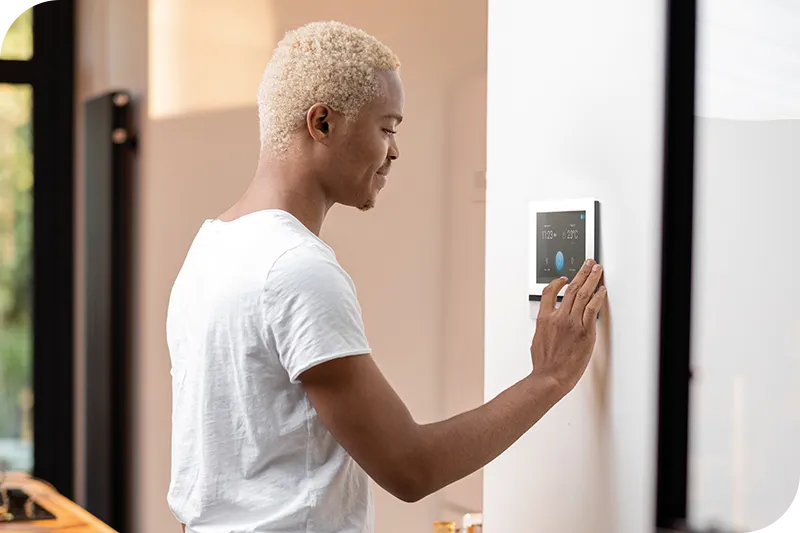Our guide to indoor stations
 Camilla Ashdown, 10. 03. 2023 | 4 min read
Camilla Ashdown, 10. 03. 2023 | 4 min read
Learn how the right indoor station can add value to projects, and what to look out for when choosing one. Want to discover the best indoor stations on the market? Check out 2N’s portfolio!

Let’s talk about indoor stations, otherwise known as indoor panels or answering units. Trust us: indoor panels are an important part of any video intercom solution, and they can not only make residents’ lives more convenient and comfortable, but they can make a big difference in keeping your customer’s buildings secure, too.
First and foremost, it's important to understand that indoor stations are just one component of a wider video intercom system – however, this doesn’t mean they are any less important. Your video intercom system for apartments might include things like IP video intercoms at the front door, IP access readers for securing common areas, and perhaps even a lift solution! Together, these components work to create a comprehensive security solution that can protect your customer’s homes.
What are indoor stations?
Indoor stations, sometimes called indoor panels or indoor panels, make up one part of a video intercom system. They are installed inside the building and allow users to accept calls from the front door and then control who they let in! Whilst they can be used for both commercial and residential projects, they are mainly used in modern residential buildings – installed inside apartments and used every day to control access to homes. Let’s discuss what’s needed from them
The power of strong integration
One key consideration when choosing indoor stations is integration. Today's buildings are more connected than ever before, and video intercom systems are no exception. When choosing an indoor panel, look for ones that can integrate with third-party systems, such as home automation and building security systems. If you do this, you’re guaranteed to please your customers with added convenience and 21st-century features. With the right integration, you can even turn the indoor station into the central control panel for the home: controlling everything from the air-conditioning to the blinds…
Never neglect design
Another important consideration is design. When it comes to indoor panels, functionality is key, but that doesn't mean that form should be overlooked. Look for indoor stations that are sleek and modern in design - they can add a touch of sophistication to buildings and will, after all, be inside people’s homes! A well-designed indoor panel can also enhance the overall user experience, making it more intuitive and user-friendly.
Our advice is to go for simplicity and a sleek finish. An indoor station with too many buttons in a garish colour will not be popular with users. For a cohesive look in modern developments, the design of the indoor station should match the design of the video intercom installed at the front door: ideally black, with white as an option for those who prefer lighter themes.
Security matters
Cyber-security is an important factor to consider when you’re placing a device in someone’s home. Look for indoor stations that comply with EU cyber-security regulations.
Choosing a company that makes their indoor stations using quality materials (that are mainly EU-sourced) is key: and bonus points if they also have their own OS – this can ensure that residents’ data is protected, and no one can listen in on conversations!
Think twice if a camera on the indoor indoor panel is necessary – it’s usually not, as nobody wants to be seen in their pyjamas! Plus, on the rare chance that someone hacks your device, having no camera will mean they can’t see the resident or the inside of their home.
Why is security so important? Even though you might not expect there to be any private data stored in the indoor unit, a network is only as weak as the weakest chain in it, and the household is connected to the unit somehow. And even if it’s not connected, your device’s IP address may be misused by hackers for example for overloading a website with visits in denial of service attacks.
Can modern indoor stations be retrofit ready?
In short – yes! But how? Choose a supplier that can work around cabling issues such as old 2-wire cables, non-existent cabling, or valuable historical buildings where it’s not possible to change cabling at all. Power calls instead via the internet. Cloud calling is a great solution that allows for more benefits than you might think, and saves on the high cost of changing cables:
- Quicker set-up: the right service will allow you to set up video calling from an IP intercom to an indoor panel in just a few minutes – no need to know technical details such as the SIP account, the authentication proxy, etc.
- Prepare for installation ahead of time: cloud services mean you can set up calls between products from anywhere – without even switching the products on! As soon as the technician has installed the equipment, everything will work instantly.
- Reliable – with the right provider cloud calling is almost equally reliable as an ethernet cable connection and can reach a reliability rate of up to 99.98%
How does it work?
You have an IP intercom at the door connected to one internet provider, and each device in each apartment is connected to its own network: it’s not always possible to get every resident to have the same internet provider – however if they’re not connected to the same local network, it means they can’t talk to each other, right? Well, if you connect the devices to a cloud network (that doesn’t care which internet provider is being used) the devices can now communicate. Intercom at the door not connected to the internet via a cable? That’s fine, all you need is an intercom with a SIM card that’s capable of video calls via 4G, for example.
Another aspect of retrofit-ready indoor stations is also the possibility to install the device flush on a wall (or even on a stand sitting on a table) – it’s often required when working on a project where residents are living in the house whilst it’s being reconstructed. Flushed-mounted devices are great because you don’t bother residents for so long, and they make less mess when compared to in-wall installation.
Prioritise user-friendly interfaces
Remember that it’s end-users who need to be able to work the devices you install, every day. You won’t want them complaining about not being able to work their indoor stations, and you certainly don’t want to deal with many technical questions and queries. That’s why the user interface of the indoor station needs to be simple and easy to use.
Let’s talk features
Which are the best modern features available in indoor stations on the market today?
- Video calling
Perhaps the most obvious is the ability to accept not only audio calls but video calls, too. Choose an indoor station that has a large, clear touchscreen and crystal-clear audio and images, and you’ll guarantee your residents know exactly who’s at the door every time. Some indoor stations even include features such as pinch-to-zoom which allows them to zoom in on the faces of visitors for even more security.
- Video messages
Along with video calls comes video messages: so when a resident misses a call from the IP intercom, the visitor can leave a message for them to replay when they return home.
- Integration with home automation
Mentioned previously, but worth mentioning again: the right indoor station should enhance a smart home and work as part of it.
- Video surveillance
When indoor stations are connected to video intercoms, they can allow residents to stream the feed from it to keep an eye on their front door at any time. What’s more, if you get an indoor station that has IP camera connectivity, they can even monitor areas where no intercom is installed, such as garages and outbuildings.
Create a truly comprehensive, totally modern access solution. Complement indoor panels with calls to residents’ mobile phones so they can answer their doors from anywhere! It allows for more security (they can monitor their front entrance no matter where they are) and great convenience – they’ll never miss a delivery again!
Make your indoor station a part of an entire video intercom solution
Nothing is better than a complete solution. Choose access readers and video intercoms from the same provider, and you’ll enjoy seamless configuration and a cohesive user experience.
In conclusion, indoor stations are an important part of any video intercom solution, and they can make a big difference in keeping buildings secure. When choosing indoor stations, consider integration, design, and modern features, and don't forget to highlight the convenience and security benefits that indoor stations can provide for residents. Thanks for reading!